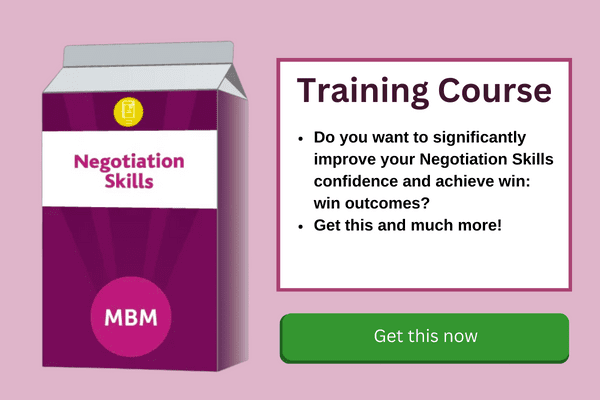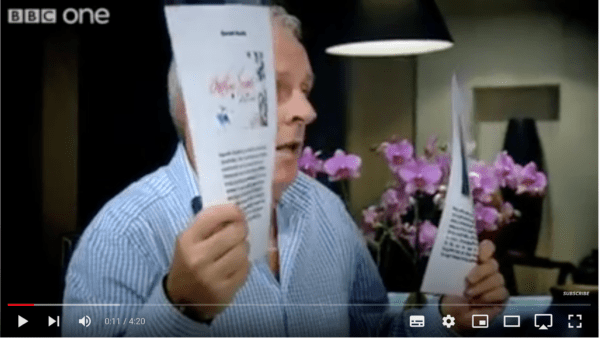This Negotiation Exercise is a Great Way to Help You & the Team to Become the Very Best Versions of Their Negotiating Selves
Plus, this negotiation exercise will help to build the team too.
Overview of the Negotiation Exercise
This negotiation case study exercise will help your team to improve their negotiation skills by watching a video together and identifying how well, or not, the people in the video negotiated. The exercise will take about 20-30 minutes and is designed to be fun, interactive, and to improve their ability to negotiate. We learn more from what we do wrong and see others do wrong than from what we, and others do right.

Instructions for the Negotiation Team Exercise
Number 1
Invite them (Not tell them) to a team meeting where you will together complete a negotiation exercise. Explain that you’ll be the facilitator and there is no preparation needed. They just need to bring themselves and a willingness to work together.
Number 2
Once your team is gathered, share the relevant instructions from the points below.
Number 3
Your first step as facilitator is to get your team ‘up for it’. There is no point in just ‘going through the motions’. Invite anyone that is just too busy to go back to their desk. Also, agree on some ground rules, like no mobile phones, and that everyone is to demand maximum engagement from everyone.
Number 4
Begin by asking the team one thing they would like to get from this negotiation exercise. Obviously, they don’t know, at this stage, what the exercise is about. Yet, they may have learning objectives that you can refer back to, during the exercise or they have points that can create a foundation for a future exercise. Good examples of learning objectives are ‘I’d like to know how to ask better questions, or ‘Be good to see how someone deals with silence’. Bad examples are ‘I’d like to negotiate better’, or ‘Know how to negotiate at all’. Focusing on getting good learning objectives is essential because you can use these to engage people.
Number 5
Next, explain that with those learning objectives captured on a flipchart, or a piece of paper, we are going to watch a video together. The Youtube clip is from BBC’s Sports Relief does The Apprentice and is 4 minutes and 20 seconds long. Watch the video all the way through once.

Number 6
Before you play the clip a second time, instruct the team that they are to identify things done well, not well , and interesting things too. They are to raise their hand or call out ‘stop’. You stop the clip, ask them to share their observation and then discuss it with the group, asking for their input and what they would do differently. The latter part – what they would do differently – is the key because this is a learning point that they will take away. Each time you stop the clip turn away from the screen to indicate to the group that as we stop there will be 2-3 minutes of discussion, and it is NOT just about watching the video again all the way through quickly. Write the learnings on a flipchart or ask someone else to, while you facilitate the discussion.
Number 7
Once you have finished the clip with observations shared, turn the group’s attention to the flipchart of learnings and ask each person to share their biggest takeaway point, why and how they would do it differently. Explain that as you go around the group, there can be no duplication of observations. So, the later they volunteer the harder it gets.

Cheat Sheet of 26 Observations of Good, Not So Good, and Interesting
This part is just for you, as the facilitator, and is useful if the group are struggling to identify the observations beyond the obvious ones. have this piece printed ready to share. You don’t have to share all the points, but a couple added into the discussion will help the group to think wider than what is obvious.
1-4
- 1. 8 seconds: She and he asks their team for input into the negotiation before they start. This is good negotiation preparation.
- 2. 15 seconds: The advice from Phil Tuffnell is poor because it does not help the other person to be a better negotiator. What is the advice that you get when you are preparing for a negotiation?
- 3. 23 seconds: Project Manager Hardeep puts out his hand to greet the other party, which is good. Yet he does not accompany it with a greeting, or a smile, which is poor.
- 4. 26 seconds: Liberal MP Lembit greets the other party with a handshake and accompanies this with a greeting and a smile. It takes 7 seconds to make an impression.

5-9
- 5. 27 seconds: Both men are touching their chins, which means that they are thinking hard about something. This is neither good or bad, but it does signal to a trained negotiator that the other party are considering what you are saying. How well do you recognise body language and use it when you are negotiating?
- 6. 30 seconds: One team is outnumbered by the other team, 5 to 2. Neither good nor bad, but needs to be recognised.
- 7. 30 seconds: The woman on the left with the black & gold watch & bracelet is not showing a united front with her colleague, by being seemingly disenagged and not portraying the same assertive attitude as the female lead negotiator. The woman to the right of the lead negotiator is also not showing a united front.
- 8. 31 seconds: Lembit is shuffling his papers which could indicate that he is poorly prepared.
- 9. 31 seconds: The woman opens with a leading closed question, ‘Shall we start with…’. Again, this is neither good or bad, but a trained negotiator recognises open & closed questions, and leading questions.
10-13
- 10. 32 seconds: The men show that they are not united by disagreeing with each other in front of the women’s team. This is poor because the other team could drive a wedge between the two men. The men have not chosen a leader negotiator, whereas the women’s team clearly has.
- 11. 40 seconds: ‘If you want to go first, we’ll take the next 3’. A great example of the ‘If you, then I’ negotiating tool.
- 12. 42 seconds: Hardeep does not recgnise the question from the girls team and asks a different question, which is far from actively listening.
- 13. 47 seconds: A good example of assertive and direct communication by the female lead negotiator with ‘I am telling you…’.

14-19
- 14. 50 seconds: The female lead negotiator, frustrated by the lack of response or commitment by the boys offers a compromise. This is a good example of being prepared and offering a concession to move forward, but remember no free fish.
- 15. 51 seconds: Hardeep responds with what is known in negotiating circles as an irrigator. Designed to irritate and is a big no-no in negotiating because it will just, well, irritate!
- 16. 54 seconds: A great question, ‘Who is your negotiator?’ because she needs to establish who is the decision maker. And also she starts to drive a wedge between the boys.
- 17. 57 seconds: Lembit shares that they have not the authority to negotiate, which will reduce their ability to negotiate because their influence is now very low. How often do you negotiate without having agreed the boundaries with your line manager beforehand?
- 18. 1 minute and 5 seconds: Further demonstrating a lack of being ‘on the same page’, which will always be exploited by the other party.
- 19. 1 minute and 9 seconds: Lembit calls for an adjournment. This is a great negotiating tool and should be used wisely.
20-23
- 20. 1 minute and 13 seconds: Hardepp apologies, which is the right thing to do to be courteous. But when negotiating it puts you on the backfoot and will make the negotiation much harder to win.
- 21. 1 minute and 20 seconds: Adjournments need to be used very wisely and effectively. It is a critical time to solve the issue, re-group and plan your next move. Not time to argue. Remember, when you adjourn so does the other team, therefore your time is precious because the other team will be re-planning also.
- 22. 2 minutes and 24 seconds: Hardeep recognises that their credibility has been lost. The team should then discuss how to solve the problem to win back their credibility. They don’t.
24-26
- 23. 2 minutes and 58 seconds: The adjournment achieved very little in terms of authority. It was a discussion that was bravado-fueled and did not support the negotiating team to do their job.
- 24. 3 minutes and 24 seconds: The two men are trying to prepare whilst walking into the negotiation. This is very poor preparation.
- 25. 3 minutes and 49 seconds: Negotiations get heated. We need to be mindful of our tone, body language and words. Phrases like, ‘You said…’, with pen pointed, whilst not irritators will rarely solve the problem. The female lead stepped-in recgnising this behaviour and stopped it.
- 26. 3 minutes 53 seconds: Lembit suggests a way to resolve the conflict without negotiating – Tossing a coin. There are 8 ways to resolve conflict and tossing a coin is arbitration, not negotiating. Like, haggling is not negotiating.
Pitfalls to Be Aware Of
Not Up for It
If the team aren’t up for it, reschedule.

Poor Learning Objectives
Don’t ‘allow’ the team to have poor learning objectives, like ‘Be a better negotiator’. Ask them to recosnider, move onto the next person and then come back to them.
What Would They Do?
Yes, the team would rarely negotiate that badly and have observations like, ‘Well, I wouldn’t have done that to begin with’. But challenge them that if they were in that situation what would they do to get out of it.




